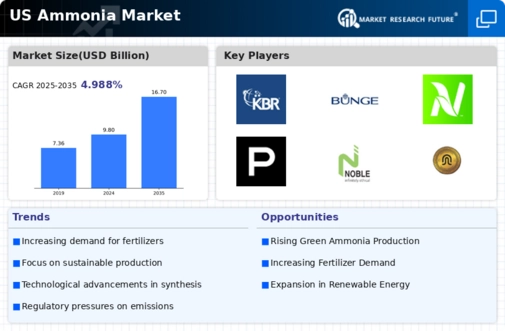The US Ammonia Market is characterized by a dynamic and competitive landscape, influenced by several factors, including production efficiencies, technological advancements, and shifts in demand driven by agricultural needs and industrial applications. Companies within this market are seeking to enhance their operational capabilities while striving to innovate and align with environmental regulations. The landscape is marked by strategic partnerships, mergers, and acquisitions that bolster production and distribution capabilities. A key aspect of the market is the focus on sustainable practices, which is becoming increasingly necessary as stakeholders call for greener solutions.
The competition in this sector remains intense as firms assess their strengths, weaknesses, market positioning, and customer engagement in the pursuit of maintaining a competitive edge. KBR holds a prominent position in the US Ammonia Market as a leader in the development and optimization of ammonia production technologies. The company is well-regarded for its advanced engineering solutions that emphasize efficiency and sustainability. With a robust portfolio that includes proprietary technologies for ammonia synthesis and a commitment to reducing carbon footprints, KBR is able to leverage its technical expertise to significantly impact the market.
The company’s presence is strengthened through its global reach, enabling it to cater to the diverse needs of clients in the agricultural and industrial sectors within the US. KBR’s ability to adapt to changing market conditions and customer requirements has solidified its reputation as a reliable partner, making it a formidable player in the ammonia production landscape. OCI Nitrogen stands out in the US Ammonia Market as a key supplier known for its comprehensive portfolio of nitrogen-based fertilizers and industrial products.
The company produces a variety of key products, including ammonia, urea, and ammonium nitrate, catering to the agricultural sector's needs for enhanced crop yields. OCI Nitrogen's strengths lie in its integrated production facilities, which not only optimize resource utilization but also reduce costs. The company is strategically positioned in the US market due to its significant production capacity and effective distribution channels, allowing it to meet the rising demand from farmers and agricultural businesses. Additionally, OCI Nitrogen has engaged in strategic mergers and acquisitions that have bolstered its market presence, providing it with greater access to key resources and technology.
This strategic approach enables OCI Nitrogen to maintain competitive pricing and enhance its service offerings, thus securing its place as a leading entity in the ammonia sector.























Leave a Comment